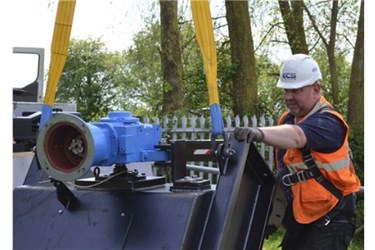Maintaining Archimedes Screw pumps

The enduring simplicity of the Archimedes screw pump continues to make it one of the most efficient pumping methods over short distances, but this efficiency should not be taken for granted. Often running 24 hours per day these workhorses of the water industry can become neglected, but implementing a comprehensive maintenance regime will ensure continued reliability and efficiency levels.
Dave Bennion, Project Manager at ECS Engineering Services, looks at the importance of maintaining these vital assets.
The Archimedes screw pump is renowned for reliability and efficiency, which is why it is employed in so many applications, especially in the water treatment industry and drainage environments. Capable of moving large quantities of water over short distances, it is ideal for maintaining water levels and pumping water contaminated with debris that would seriously damage a centrifugal pump.
The maintenance regime for a screw pump is considerably less complicated than that for a centrifugal pump which, unlike Archimedes’ design, can become blocked or overheat if it runs dry. Modern bottom bearings, such as the Eco-friendly bearing from Landustrie, which locates the screw position in the trough, are now sealed for life, removing the need to check grease pumps and lubrication lines regularly.
While the lower bearing is usually submersed in water and inaccessible, the top bearing, which is located close to the motor drive and gearbox, will require maintenance checks to be carried out. Automatic grease cartridges are often employed on these bearings as well as on the gearbox so a simple inspection of the grease level is all that is required, with replacement of the cartridge as necessary.
With many of these pumps working 24 hours per day, even the hardest concrete trough will start to wear in time, as will the flights of the screw pump. The speed of this erosion is dependent on the amount of debris suspended and floating in the water as well as levels of various chemicals such as hydrogen sulphide, ammonia and sulphuric acid, all of which can be found in waste water treatment environments.
Physical and chemical erosion of the trough increases the gap between the outer edge of the screw pump flight and the trough itself, which allows more water to pass the flight rather than travel up the trough. This will clearly affect the overall efficiency of the screw pump as more energy will be required to transport the same volume of water.
Although this is a very gradual process there comes a point where the increased energy costs and reduced performance necessitate a refurbishment of the screw and trough. In essence this involves welding a new section onto the flights of the screw pump to return the outside diameter to its original dimensions and then remaking the trough to provide the optimum flight to trough clearance.
This type of project is something that ECS Engineering Services is regularly involved with, providing a complete turnkey solution that minimises any disruption to the operation of the treatment works. Having removed the screw for refurbishment, the on-site team would expect to break out the original concrete trough using a pneumatic breaker that is fitted to a remote controlled, tracked vehicle.
Due to the access difficulties involved with refurbishing the concrete trough it is important to carry out the work in the safest manner possible. Once the trough has been properly prepared, fresh concrete is poured and a new trough starts to take shape. The finished surface is created by reinstalling the screw which has temporary screeding bars attached to the flights and slowly rotating the screw to give the perfect clearance.
While the flights on the screw were refurbished the bearings can also be replaced and in cases where the bottom bearing has a forced lubrication feed, this can be replaced with a new stainless steel, eco-friendly bearing which is sealed for life and requires no annual maintenance. Top bearings can be assessed for wear and replaced as required to ensure the refurbished installation will continue to operate for many years to come.
ECS Engineering Services is able to offer an on-site inspection service, carried out by experienced engineers to assess the condition and expected lifetime of any screw pump installation. If any maintenance is required, ECS can deliver a complete service offering, including, if necessary, renewal of the screw itself with support from its long established partner Landustrie.
“The image(s) distributed with this press release may only be used to accompany this copy, and are subject to copyright. Please contact DMA Europa if you wish to license the image for further use.”
About ECS Engineering Services
ECS Engineering Services has over 20 years experience in delivering high quality, reliable and cost effective engineering solutions, specialising in bespoke design and construction of water, energy and environmental processing and management projects.
In conjunction with key supply partners, ECS has the expertise and capacity to design and install a wide range of water control engineering projects. With in-house fabrication services, which have CE Marking approval to EXC3, well equipped and highly skilled engineers can also complete structural steelwork, bespoke fabrication work and access metalwork to the highest standard.
With a complete range of site services available, ECS offers a full turnkey project managed service for mechanical and electrical installations including managing civils contractors and supplying pipework, control and automation work to ensure that every installation is installed and commissioned to the highest standard. Existing clients include the majority of the UK Water Utility companies, Government Agencies and Internal Drainage Boards.
Source: ECS Engineering Services
